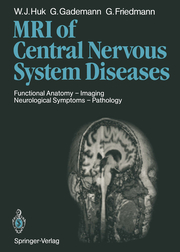Detailansicht
Magnetic Resonance Imaging of Central Nervous System Diseases
Functional Anatomy Imaging Neurological Symptoms Pathology
ISBN/EAN: 9783642725708
Umbreit-Nr.: 4369015
Sprache:
Englisch
Umfang: xvi, 452 S.
Format in cm:
Einband:
kartoniertes Buch
Erschienen am 16.12.2011
Auflage: 1/1990
- Zusatztext
- Magnetic resonance imaging (MRI) is a new and still rapidly developing imaging technique which requires a new approach to image interpreta tion. Radiologists are compelled to translate their experience accumulat ed from X-ray techniques into the language of MRI, and likewise stu dents of radiology and interested clinicians need special training in both languages. Out of this necessity emerged the concept of this book as a manual on the application and evaluation of proton MRI for the radiolo gist and as a guide for the referring physician who wants to learn about the diagnostic value of MRI in specific conditions. After a short section on the basic principles of MRI, the contrast mechanisms of present-day imaging techniques, knowledge of which is essential for the analysis of relaxation times, are described in greater de tail. This is followed by a demonstration of functional neuroanatomy us ing three-dimensional view of MR images and a synopsis of frequent neurological symptoms and their topographic correlations, which will fa cilitate examination strategy with respect to both accurate diagnosis and economy.
- Kurztext
- Inhaltsangabe1 Physical Principles and Techniques of MR Imaging.- 1.1 Physical Principles.- 1.1.1 Historical Background.- 1.1.2 Properties of Atomic Nuclei.- 1.1.3 Situation in the Absence of an Applied Magnetic Field.- 1.1.4. Situation in the Presence on an Applied Magnetic Field.- 1.1.5 Resonance.- 1.1.6 Induction.- 1.1.7 Relaxation.- 1.1.8 Significance of Relaxation Times.- 1.1.9 Chemical Shift.- 1.2 Techniques of MR Imaging.- 1.2.1 Magnet.- 1.2.2 Radiofrequency Equipment.- 1.2.3 Surface Coils.- 1.2.4 Gradient System.- 1.2.5 Forming an Image.- 1.2.6 Central Control Unit.- 1.3 Pulse Sequences and Image Contrasts.- 1.3.1 Aspects of MR Image Quality.- 1.3.2 Pulse Sequences.- 1.3.3 Contrast Agents.- 1.3.4 Flow Phenomena.- 1.3.5 Image Artifacts.- 1.4 New Approaches in Clinical MR.- 1.4.1 Fast Imaging.- 1.4.2 Blood Flow and MR Angiography.- 1.4.3 Tissue Characterization.- 1.4.4 Spectroscopy and Chemical Shift Imaging.- References.- 2 Normal Anatomy of the Central Nervous System.- 2.1 Orientation.- 2.1.1 Organization of the Atlas.- 2.1.2 Coordinate Systems for the Central Nervous System.- 2.1.3 Ventricular System.- 2.1.4 Functional Systems.- 2.2 Cerebral Cortex.- 2.2.1 Lobes, Gyri, and Sulci.- 2.2.2 Functional Anatomy.- 2.3 Diencephalon and Basal Ganglia.- 2.3.1 Basic Anatomy.- 2.3.2 Pituitary Gland.- 2.3.3 Hypothalamus.- 2.3.4 Thalamus.- 2.3.5 Functional Anatomy.- 2.4 Midbrain.- 2.4.1 Basic Anatomy.- 2.4.2 Functional Anatomy.- 2.5 Posterior Fossa.- 2.5.1 Basic Anatomy.- 2.5.2 Pons and Medulla Oblongata.- 2.5.3 Cerebellum.- 2.5.4 Basal Cranial Nerves.- 2.5.5 Functional Anatomy.- 2.6 Optical System.- 2.6.1 Basic Anatomy.- 2.6.2 Functional Anatomy.- 2.7 Acoustic System.- 2.7.1 Basic Anatomy.- 2.7.2 Functional Anatomy.- 2.8 Cerebral Blood Supply.- 2.8.1 Basic Anatomy.- 2.8.2 Arterial System.- 2.8.3 Venous System.- 2.8.4 Supply Areas of the Cerebral Arteries.- 2.9 Spinal Cord.- 2.9.1 Basic Anatomy.- 2.9.2 Cervical Cord.- 2.9.3 Thoracic Cord.- 2.9.4 Lumbosacral Region.- 2.9.5 Functional Anatomy.- References.- 3 Practical Aspects of the MR Examination.- 3.1 Preparations.- 3.1.1 Explaining the Procedure to the Patient.- 3.1.2 Positioning.- 3.2 Examination Procedure.- 3.2.1 Anatomic Orientation.- 3.2.2 Demonstration or Exclusion of Disease.- 3.2.3 Differentiation of Disease.- 3.3 Sedation, Anesthesia, and Anesthesiology Monitoring During MR Examinations.- 3.3.1 Monitoring.- 3.3.2 Sedation.- 3.3.3 General Anesthesia.- 3.4 Side Effects and Contraindications.- 3.4.1 Biological Effects.- 3.4.2 Practical Effects.- References.- 4 Symptoms and Pathologic Anatomy: A Tabular Listing.- 5 General Aspects of the MR Signal Pattern of Certain Normal and Pathologic Structures.- 5.1 Brain Edema.- 5.2 Intracranial Hemorrhage and Iron Metabolism.- 5.3 Practical Aspects of Blood and CSF Flow.- 5.4 Effects of Radiotherapy on Brain and Spinal Cord Tumors.- 5.5 Effect of Contrast Agent (Gadolinium-DTPA) on the MR Appearance of Normal Tissue.- References.- 6 Magnetic Resonance Imaging of the Brain in Childhood: Development and Pathology.- 6.1 Introduction.- 6.2 Technical Aspects.- 6.3 Normal Appearance.- 6.4 Intracranial Hemorrhage.- 6.5 Infarction.- 6.6 Cysts and Leukomalacias.- 6.7 Hydrocephalus.- 6.8 Congenital Malformations.- 6.9 White Matter Disease.- 6.10 Infection.- 6.11 Delays or Deficits in Myelination.- 6.12 Tumors.- 6.13 Other Diseases.- 6.14 Follow-Up Examination.- 6.15 Conclusion.- References.- 7 Malformations of the CNS.- 7.1 Review of Ontogeny.- 7.2 MR Imaging of CNS Malformations.- 7.3 Midline Closure Defects (Neural Tube Defects, Dysraphic Disorders).- 7.3.1 Midline Closure Defects of the Brain.- 7.3.2 Midline Closure Defects of the Cerebellum.- 7.3.3 Midline Closure Defects of the Spine.- 7.3.4 Dysraphic Disorders of the Spinal Cord.- 7.4 Malformations of the Commissures and Midline Structures.- 7.4.1 Holoprosencephaly.- 7.4.2 Agenesis of the Corpus Callosum.- 7.4.3 Anomalies of the Septum Pellucidum.- 7.5 Anomalies of Cell Migration.- 7.5.1 Ectopias and H
